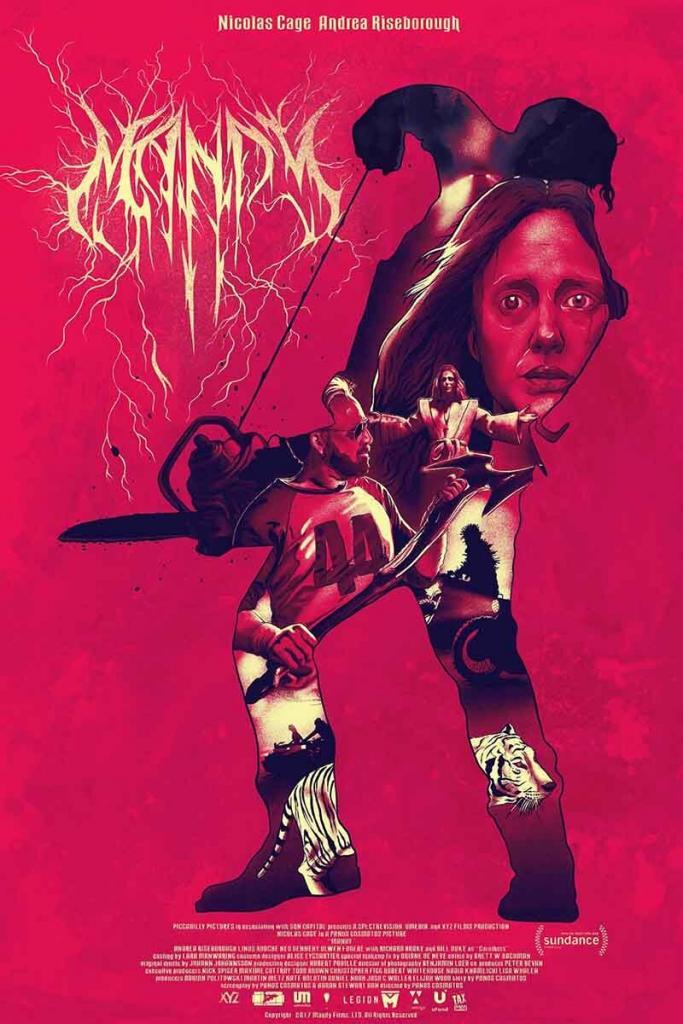Panos Cosmatos creates love letters to cinema. His films are packed with references, flagrant horror conventions and meticulous pairings of sound and imagery to invoke a plethora of emotions, generally soaked in an 80’s styled neon-nightmare of color. The 2018 Horror movieMandy is no exception.
If this style was wholly evident in his 2010 directorial debut Beyond The Black Rainbow then it applies doubly for his following film, 2018’s phantasmagoric horror film masterpiece Mandy. By the time of his sophomore effort, Mandy, Cosmatos had truly found his feet. After witnessing the trailer for Mandy I couldn’t have been more sold. It seemed to scream: “Yep, this is everything you’ve ever wanted from a film. Look, there’s even a chainsaw fight!”
Armed with a similar scale of plot to his first film (this time stemming from a marathon of Charles Bronson’s Death Wish series) and a stellar cast including the likes of Andrea Risebrough and the legendary Nicholas Cage, whose horror credits range from cosmic horror to pure murderous rage is notable here. Mandy gives the impression of coming from a fantasy horror fever dream of uncanny nostalgia.
When a couple’s idyllic woodland existence is targeted by a psychotic pseudo-christian cult and shattered into cosmic terror, Red (Cage) sets out on a bloody rampage of revenge and crushed skulls.
The film’s opening to King Crimson’s ‘Starless’ and a sweeping, grain-soaked shot over endless pine forests should send chills through any hyper-fan of the VHS age. Like Beyond The Black Rainbow, Mandy takes its time to tell its tale, though its ideas feel more fleshed out, its every frame feels more meticulously planned and its inspirational roots are worn as badges of honor.
Mandy is dense with references; from the demonic bikers The Black Skulls appearing a combination of the cenobites from Hellraiser and a Mad Max-esque road gang to Bill Duke himself appearing to give Red some advice and arm him for his savage quest. The film’s ethos appears to be Heavy Metal (or love’s vengeance, if you like) against religion, or narcissism under religion’s guise, which may seem almost juvenile had it not been for the repeated self-aware references to rock and roll and heavy metal music throughout. (see: the film’s opening quote).

Music plays as big a part in Mandy as anything, boasting a rich and emotional score from Johan Johannson made all the more morbidly effective by his tragic passing not long after the film’s release. The score is an eclectic mix of heavy retro synth, moving orchestral passages and devastating guitar distortion from drone band Sunn 0)))’s Stephen O Malley which seems to have been written alongside the film’s creation to ensure their optimal convergence into a single cinematic force.
To use such long, atmospheric takes to portray a story so devastating and emotionally charged requires acting talent. The entire cast of Mandy brings something new to the table, from Nicholas Cage’s halfway-point switch from content affection to savage insanity to Linus Roache’s seedy, delusional portrayal of Cult Leader Jeremiah Sands. It seems as though Cosmatos is content to roll the camera and just let the actors go with it, each scene feeling loosely organic alongside it’s detailed visual planning. Personally I rate this as Nicholas Cage’s best performance, and the one that solidified my place in the “Cage: good or bad?” argument. Though his balls-to-the wall approach is highly entertaining, it won’t be for everyone.
Mandy is very ‘one man’s vision’ which does not necessarily equate to an accessible film. It’s a bold statement, even in structure where the films titles don’t even appear until around the halfway point, indicating that what you’ve just watched was a mere setup for the madness that is about to begin.
Mandy is the story of a man who loses everything, allowing the darkness to fully envelop him into a world of brutally violent vengeance. It is a glorious leap from its predecessor and hopefully a preemptive look into a future of darkness from Panos Cosmatos’ mind. Beware the Black Skulls and remember: A psychotic drowns where the mystic swims.
Joe first knew he wanted to write in year six after plaguing his teacher’s dreams with a harrowing story of World War prisoners and an insidious ‘book of the dead’. Clearly infatuated with horror, and wearing his influences on his sleeve, he dabbled in some smaller pieces before starting work on his condensed sci-fi epic, System Reset in 2013.Once this was published he began work on many smaller horror stories and poems in bid to harness and connect with his own fears and passions and build on his craft.
Joe is obsessed with atmosphere and aesthetic, big concepts and even bigger senses of scale, feeding on cosmic horror of the deep sea and vastness of space and the emotions these can invoke. His main fixes within the dark arts include horror films, extreme metal music and the bleakest of poetry and science fiction literature.
He holds a deep respect for plot, creative flow and the context of art, and hopes to forge deeper connections between them around filmmakers dabbling in the dark and macabre.

